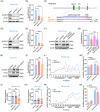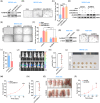PUS7-dependent pseudouridylation of ALKBH3 mRNA inhibits gastric cancer progression
- PMID: 39175405
- PMCID: PMC11341916
- DOI: 10.1002/ctm2.1811
PUS7-dependent pseudouridylation of ALKBH3 mRNA inhibits gastric cancer progression
Abstract
Background: RNA pseudouridylation is a critical post-transcriptional modification that influences gene expression and impacts various biological functions. Despite its significance, the role of mRNA pseudouridylation in cancer remains poorly understood. This study investigates the impact of pseudouridine synthase 7 (PUS7)-mediated pseudouridylation of Alpha-ketoglutarate-dependent Dioxygenase alkB Homolog 3 (ALKBH3) mRNA in gastric cancer.
Methods: Immunohistochemistry and Western blotting were used to assess PUS7 protein levels in human gastric cancer tissues. The relationship between PUS7 and gastric cancer progression was examined using 3D colony formation assays and subcutaneous xenograft models. Real-time quantitative PCR (RT-qPCR), Western blotting, and polysome profiling assays were conducted to investigate how PUS7 regulates ALKBH3. A locus-specific pseudouridine (Ψ) detection assay was used to identify Ψ sites on ALKBH3 mRNA.
Results: Our findings indicate a significant reduction of PUS7 in gastric cancer tissues compared to adjacent non-tumour tissues. Functional analyses reveal that PUS7 inhibits gastric cancer cell proliferation and tumour growth via its catalytic activity. Additionally, PUS7 enhances the translation efficiency of ALKBH3 mRNA by modifying the U696 site with pseudouridine, thereby attenuating tumour growth. Importantly, ALKBH3 functions as a tumour suppressor in gastric cancer, with its expression closely correlated with PUS7 levels in tumour tissues.
Conclusions: PUS7-dependent pseudouridylation of ALKBH3 mRNA enhances its translation, thereby suppressing gastric cancer progression. These findings highlight the potential significance of mRNA pseudouridylation in cancer biology and suggest a therapeutic target for gastric cancer.
Highlights: PUS7 enhances the translation efficiency of ALKBH3 through its pseudouridylation activity on ALKBH3 mRNA, thereby inhibiting gastric tumourigenesis. The expression levels of PUS7 and ALKBH3 are significantly correlated in gastric tumours, which may be potential prognostic predictors and therapeutic targets for patients with gastric cancer.
Keywords: alkbh3; gastric cancer; pseudouridylation; pus7.
© 2024 The Author(s). Clinical and Translational Medicine published by John Wiley & Sons Australia, Ltd on behalf of Shanghai Institute of Clinical Bioinformatics.
Conflict of interest statement
The authors declare they have no conflicts of interest.
Figures







References
-
- Cerneckis J, Cui Q, He C, et al. Decoding pseudouridine: an emerging target for therapeutic development. Trends Pharmacol Sci. 2022;43:522‐535. - PubMed
-
- Ruggero D, Grisendi S, Piazza F, et al. Dyskeratosis congenita and cancer in mice deficient in ribosomal RNA modification. Science. 2003;299:259‐262. - PubMed
MeSH terms
Substances
Grants and funding
LinkOut - more resources
Full Text Sources
Medical
Molecular Biology Databases
